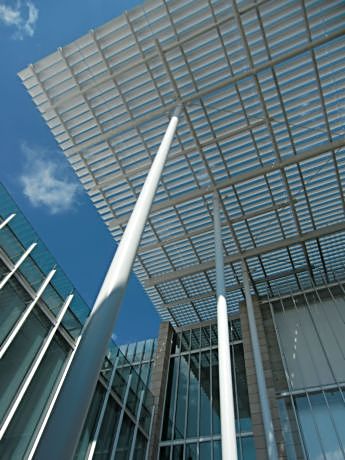
Architecture students and aficionados travel to Chicago to see its famed and ground-breaking buildings. Tourists quite often take Chicago’s architecture boat rides offered by the Architecture Foundation and other boat companies that ply the Chicago River. By the way, all the boat tours are good and have knowledgeable guides. However, to really see most of downtown Chicago’s exceptional architecture examples, you should walk.
Architecture is second in a five part series on walking destinations in Chicago that includes art, theater, shopping and restaurants. Combine them for a day in the city.
You can begin your walk anywhere downtown to gaze up or into the lobby of an architecturally important building. But because Millennium Park is a destination point for tourists, we’ll start there.
Near Millennium Park
To the south, across Monroe Drive is the Art Institute of Chicago’s Modern Wing.
From Millennium Park walk the Nichols Bridgeway over Monroe Drive to the Modern Wing’s upper level. You have a great view of the building’s “flying carpet” roof, a computer-regulated system of blades that appropriately screen the light for art.
You’ll end up next to the Bluhm Family Terrace where you get a birds eye view and photo op of Chicago’s skyline. The Bridgeway and the Modern Wing were designed by Pritzker Prize winner Renzo Piano and opened in May 2009.
Go down a level to Café Moderno for latte, tea and a view of Griffin Court, the Modern Wing’s impressive hall.
On Griffin’s main level, walk through the double glass doors into a transition area from old to new and go left. You will pas Chagall’s “America” windows and down a few steps to see Adler & Sullivan’s Stock Exchange Trading (1883-1896) Room. The firm of Vinci & Kenny reconstructed it for its Art Institute location 1970-77.
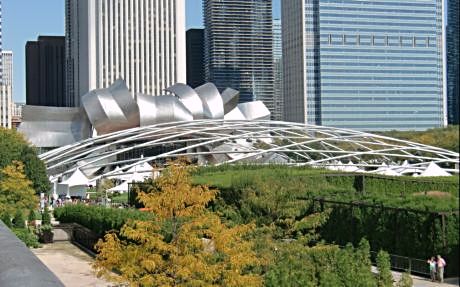
Back in Millennium Park it’s hard to miss Frank Ghery’s sculpturally-topped Jay Pritzker Pavilion, the park’s outdoor concert venue. Dedicated in July 2004, its trellis of steel pipes contains a sound system extending over the seats and concert lawn.
In Millennium Park, look north on Columbus Drive to see a building whose outside appears to ripple. It is the Leed-certified Radison Blu Aqua, a hotel designed by Jeanne Gang and her innovative, Chicago-based Studio Gang firm. Completed in 2010, its balconies create the contemporary ripple design but also shade the rooms without blocking their views.
Near the Chicago River
Walk west from the hotel to see the green, art deco-styled Carbide and Carbon Building at 230 N. Michigan Ave., home to the Hard Rock Hotel. Built by the Burnham Brothers in 1929. The building has art deco layered setbacks and sides. Stop in front to admire its decorated entry. The brothers are Daniel Hudson Burnham, Jr and Hubert Burnham, sons of Chicago architect and city planner Daniel Hudson Burnham (1846-1912).
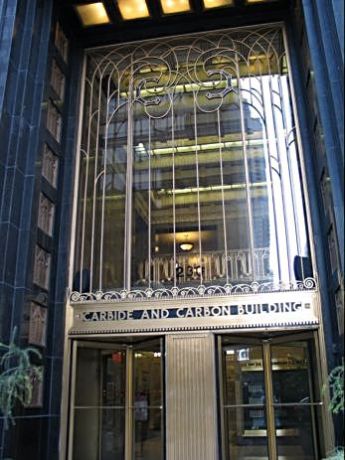
Chicago has so many art deco buildings that if you want to concentrate just on that style take the Chicago Architecture Foundation Art Deco walking tour.
Wacker Drive and the Chicago River are a few steps north. Look or go across to The Langham, Chicago on Wabash Avenue. You might not expect London’s longtime (1865) upscale hotel to occupy such a no-nonsense structure. The hotel’s lobby and dining spaces on the second floor are gorgeously elegant but the building, itself, is significant. The Langham Chicago opened in 2013 in the first 13 floors of a 52-story, 1972 building that Ludwig Mies Van der Rohe designed for IBM.
Across the road west from The Langham are two round towers you might have seen in the movies. They are Bertrand Goldberg’s Marina City. At 65-stories they were the world’s highest residential structures when built in 1964 as Goldberg’s urban mixed-use model. Their corncob-style gave each apartment a private view.
Designed on a platform as a city-within-a- city, the complex’s current commercial use includes the House of Blues, a hotel, restaurants, cleaners, realty, and convenience store, parking garages and marina.
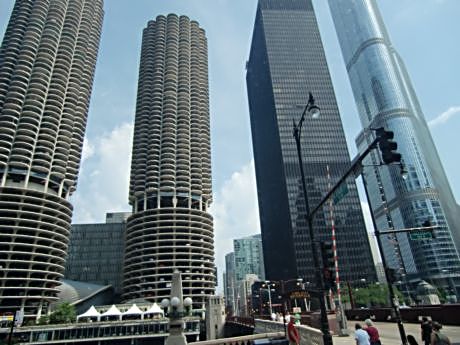
In and near the Loop
Chicago’s Loop refers to buildings within the “L” tracks that circle some of the downtown. But building near the tracks are also considered in the Loop.
From the river start back south on Dearborn Street to the James R. Thompson Center at Randolph Street. Although occupants complain it is hard to cool and heat, the wrapped-in-glass building stands out instead of blending with its neighbors.
Designed by Helmut Jahn and his Murphy & Jahn firm it was completed in 1985 as a State of Illinois building. Later renamed the Thompson Center for Governor James Thompson, the structure has a 160 foot rotunda surrounded by 16 stories of government and commercial offices with a food court on its lower level.
Go inside to gaze up, then take an escalator up a level to the Illinois Art Museum and Artisans Shop that feature Illinois artists.
Back outside, walk west to LaSalle St. to admire the art deco, waterfall front and sculpture decoration of the State of Illinois Building. Located at 160 N. LaSalle St, it was designed by the Burnham Brothers, completed in 1924 and renovated by the Holabird and Root in 1992.
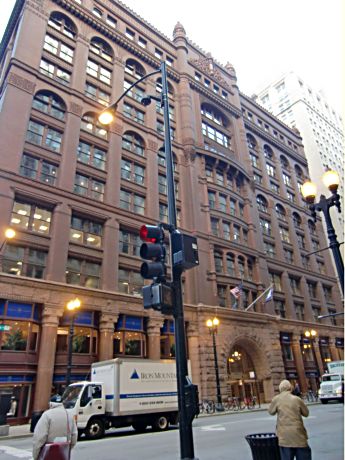
Stay on LaSalle and walk south to see The Rookery. Designed by Burnham and Root and completed in 1988, the building’s lobby, 209 LaSalle St., was redesigned by Frank Lloyd Wright in 1905. Snap photos of its staircase. Everyone does.
The Rookery is in the financial district which is a good vantage point to admire the Chicago Board of Trade. A commanding art deco icon at the end of LaSalle Street the CBOT building is at 141 W. Jackson Blvd.
Designed by Holabird & Root, the 1930 skyscraper’s tiered set-backs and decoration have made it an art deco icon with Chicago and national landmark status.
A three-story high statue of Ceres holding a sheaf of wheat and bag of corn sits atop its copper, pyramid-shaped roof.. By the way, wheat sheaves are often used in art deco decoration.
Speaking of iconic buildings, head east to Michigan Avenue, then south to Congress Parkway to visit the Auditorium Theatre.
The Dankmar Adler and Louis Sullivan designed 1899 stone structure was built as an opera house and hotel with Sullivan’s distinctive arches. Known also for its excellent acoustics, the theater is a concert and show venue that is also home to the Joffrey ballet.
With all that walking you are entitled to splurge at lunch or dinner so watch for restaurants next in the series and combine them with art or architecture.
Photos (C) Jodie Jacobs

One thought on “Chicago architecture is worth seeing up close and personal”
Comments are closed.